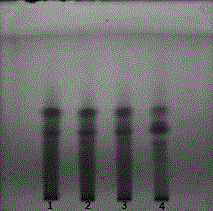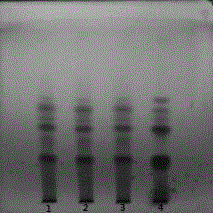Thin-layer chromatography identification method of carbonized herb processed product
A technique of thin-layer chromatography and processed products, applied in the field of quality testing of traditional Chinese medicines, can solve the problems of different processing degrees, uneven quality of charcoal decoction pieces, lack of identification items of charcoal medicine pieces, etc., and achieves strong specificity and comprehensive testing results. , identify the effect of strong specificity
- Summary
- Abstract
- Description
- Claims
- Application Information
AI Technical Summary
Problems solved by technology
Method used
Image
Examples
experiment example 1
[0051] Experimental example 1 Thin-layer identification of orientalis charcoal
[0052] Take 4.0g of orientalis charcoal powder, put it in a conical flask, add 30ml of 15% hydrochloric acid solution, heat it in a 98°C water bath for 60 minutes, let it cool, and filter; extract the filtrate twice with ether, 20ml each time, and combine ether solution, evaporated to dryness; add methanol 1ml to the residue to dissolve, as the test solution. In addition, 1.0 g of Arborvitae leaf reference medicinal material was taken, and the reference medicinal material solution was prepared with the preparation method of the test sample. According to the thin-layer chromatography ("Chinese Pharmacopoeia" 2010 edition, an appendix VIB) test, absorb 5 μl each of the test solution and the control medicinal solution, and spot on the same silica gel GF respectively. 254 On the TLC plate, use toluene-ethyl formate-formic acid (5:5:0.5) as the developer, develop, take it out, dry it, and inspect it...
experiment example 2
[0053] TLC identification of experimental example 2 Burnet charcoal
[0054] Take 3.0g of Burnet charcoal powder, put it in a conical flask, add 30ml of 20% hydrochloric acid solution, heat and reflux at 110°C for 45 minutes, let cool, and filter; the filtrate is extracted twice with ether, 20ml each time, and the ether solution is combined, Evaporate to dryness; add methanol 1ml to the residue to dissolve, as the test solution. Another Burnet reference medicinal material 1.0g, the same preparation method as the test sample to prepare the reference medicinal solution. According to the thin-layer chromatography ("Chinese Pharmacopoeia" 2010 edition, an appendix VIB) test, absorb 5 μl each of the test solution and the control medicinal solution, and spot on the same silica gel GF respectively. 254 On the TLC plate, use toluene-ethyl formate-formic acid (5:5:0.5) as the developer, develop, take it out, dry it, and inspect it under an ultraviolet lamp (254nm); Figure 3-4 , in...
experiment example 3
[0055] TLC identification of experimental example 3 vinegar moxa charcoal
[0056] Take 4.0g of vinegar moxa powder, put it in a conical flask, add 30ml of 15% hydrochloric acid solution, heat it in a water bath at 100°C for 60 minutes, let it cool, and filter; extract the filtrate twice with ether, 20ml each time, and combine ether solution, evaporated to dryness; add methanol 1ml to the residue to dissolve, as the test solution. Another 1.0 g of Artemisia argyi reference drug was taken, and the reference drug solution was prepared with the same preparation method as the test sample. According to the thin-layer chromatography ("Chinese Pharmacopoeia" 2010 edition, an appendix VIB) test, absorb 5 μl each of the test solution and the control medicinal solution, and spot on the same silica gel GF respectively. 254 On the TLC plate, use toluene-ethyl formate-formic acid (5:5:0.5) as the developer, develop, take it out, dry it, and inspect it under an ultraviolet lamp (254nm); ...
PUM
 Login to View More
Login to View More Abstract
Description
Claims
Application Information
 Login to View More
Login to View More - R&D
- Intellectual Property
- Life Sciences
- Materials
- Tech Scout
- Unparalleled Data Quality
- Higher Quality Content
- 60% Fewer Hallucinations
Browse by: Latest US Patents, China's latest patents, Technical Efficacy Thesaurus, Application Domain, Technology Topic, Popular Technical Reports.
© 2025 PatSnap. All rights reserved.Legal|Privacy policy|Modern Slavery Act Transparency Statement|Sitemap|About US| Contact US: help@patsnap.com



